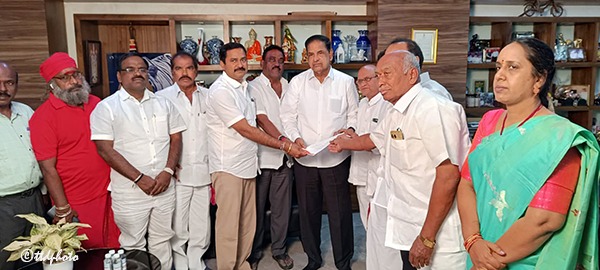

Authored article by Dr.S.L.N.T.Srinivas
Member, All India Authors Group
Ministry of Cooperation, Govt. of India
NEW DELHI, AUGUST 07, 2025: In a landmark event that marks a turning point for India’s cooperative movement, Union Home Minister and Minister of Cooperation, Shri Amit Shah, officially unveiled the National Cooperative Policy – 2025 in New Delhi. The announcement has been hailed as a historic move that aligns with the Government’s commitment to “Sahkar Se Samriddhi”—Prosperity through Cooperation—and sets an ambitious vision to reshape the cooperative landscape of India over the next two decades.
The policy aims to triple the cooperative sector’s contribution to GDP by 2034, while integrating over 50 crore active members into the cooperative framework across diverse sectors.
A Long-Term Vision Rooted in Collective Growth
Speaking at the launch ceremony, Shri Amit Shah termed the policy as both visionary and transformative, crafted under the leadership of Prime Minister Shri Narendra Modi. He emphasized that while te first cooperative policy was introduced in 2002 under the Atal Bihari Vajpayee government, this second edition—formulated after 23 years—symbolizes the BJP-led Government’s enduring commitment to the cooperative model as a tool for inclusive and participatory development.
The event witnessed participation from several key dignitaries, including state ministers, officials of the Ministry of Cooperation, Cooperation Secretary Ashish Kumar Bhutani, and former Union Minister Shri Suresh Prabhu, who chaired the policy drafting committee.
Policy Goals: Making Cooperatives Central to Bharat’s Economic Narrative
Shri Shah outlined a set of bold, quantifiable objectives that reflect the policy’s intent to catalyze widespread change:
- Triple the GDP contribution of the cooperative sector by 2034.
- Establish one cooperative society in every village to ensure deep rural penetration.
- Develop five model cooperative villages per tehsil, to serve as examples of self-sustaining ecosystems.
- Expand cooperative scope to non-traditional sectors such as green energy, health, tourism, taxi services, and insurance.
By venturing into new domains, the policy intends to make the cooperative movement not just socially relevant but economically competitive in the contemporary Indian economy.
Technology, Transparency, and Talent at the Core
At the heart of the National Cooperative Policy 2025 is a vision to make cooperative societies professional, technology-enabled, and future-ready. The policy lays out plans for:
- Cluster-based monitoring systems, ensuring better oversight and performance tracking.
- Transparent financial practices, including digitized accounting, auditing, and governance.
- Training and skilling programs, supported by institutions like the newly launched Tribhuvan Sahkari University.
- Digital inclusion of PACS (Primary Agricultural Credit Societies) across more than 25 activities—ranging from LPG and fertilizer distribution to managing Jan Aushadhi Kendras and government welfare schemes like PM Surya Ghar Yojana.
The ongoing PACS computerization project—already nearing completion for over 45,000 societies—will make India a global model in cooperative digitization.
83 Interventions, 6 Strategic Pillars
Shah mentioned that the policy is based on 83 major interventions, with 58 already completed and 3 fully implemented. The entire roadmap is structured around six strategic pillars:
- Inclusivity and Deep Reach – Ensuring cooperatives serve all regions and communities.
- rofessionalization – Moving from informal functioning to structured, accountable operations.
- Technology Integration – Leveraging digital tools for efficiency and transparency.
- Expansion of Sectors – Going beyond agriculture to services, industry, and trade.
- Global Outreach – Positioning Indian cooperatives as global exporters through National Cooperative Exports Ltd.
- Parity in Financial Treatment – Ensuring cooperative banks receive the same regulatory and policy treatment as commercial banks.
These pillars provide a comprehensive structure for long-term impact.
Employment and Economic Multiplier Effects
The Minister also stressed that the cooperative sector must be viewed as an engine for employment generation, particularly in rural and semi-urban India. The policy identifies the potential to create millions of livelihoods through decentralised, democratic, and self-owned enterprises.
The upcoming Sahkar Taxi Scheme, expected to be launched later this year, is one such example—offering full ownership and income autonomy to taxi drivers under a cooperative framework.
Changing the Narrative Around Cooperatives
In a reflective note, Shri Amit Shah recalled how cooperatives were once dismissed as an outdated model. “There was a time when people said cooperation had no future. Today, the future belongs to cooperation,” he said, receiving applause from the audience.
He noted that India’s cooperative philosophy has always been rooted in people-centric development, where millions contribute small amounts to create large, scalable, and sustainable institutions. This participatory model, he asserted, is the most suited to achieve Viksit Bharat 2047—a developed India by the 100th year of independence.
Restoring Dignity and Trust
Perhaps the most human aspect of the new policy is its focus on restoring dignity, self-reliance, and trust in every member of a cooperative. Shah concluded that the policy is not just a roadmap for economic gain but also a reaffirmation of India’s belief in inclusive and cooperative-driven growth.
The National Cooperative Policy 2025 stands as a beacon of that vision, promising to guide India’s cooperative sector for the next quarter century—and beyond.




